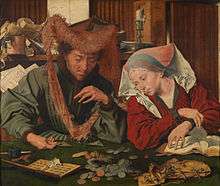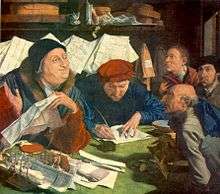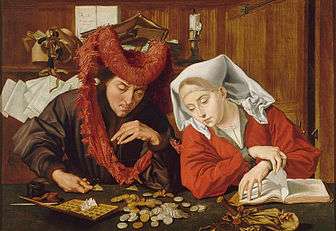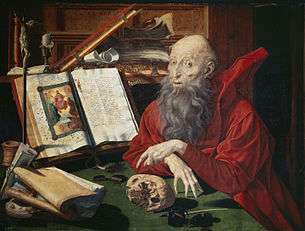Marinus van Reymerswaele
_-_The_Money_Changers_-_Google_Art_Project.jpg)
Marinus Claeszoon van Reymerswaele (c.1490–c.1546) was a Dutch painter.[1] [2]
Biography

_Saint_Jerome_in_his_study.jpg)

Marinus van Reymerswaele received later the name of the city of Reimerswaal, Netherlands, where he was born and where he worked, at least from 1533-1540. In the latter year he moved to Goes, where he died around 1546. He is also named Marinus de Seeu (from Zeeland, a province of the Netherlands). He studied at the University of Leuven (1504) and was trained as a painter in Antwerp (1509). His name is known from a small number of signed panels. A number of other paintings are attributed to Marinus on stylistic grounds. His oeuvre consists of a relatively small numbers of themes only, mostly adapted from Quentin Massys and Albrecht Dürer:
- The moneychanger and his wife
- Two tax collectors
- The lawyer’s office
- Saint Jerome in his study
- The calling of Matthew
A large group of tax collectors are wrongly attributed to Marinus. His themes were popular in the sixteenth century and his paintings copied many times.
Signed work
- Antwerp, Royal Museum of Fine Arts
- Saint Jerome in his study (1541)
- Dresden, Gemäldegalerie Alte Meister
- The moneychanger and his wife (1541)
- El Escorial, Escorial
- The moneychanger and his wife (1538)
- Florence, Bargello
- The moneychanger and his wife (1540)
- Kopenhagen, Statens Museum for Kunst
- The moneychanger and his wife (1540)
- Madrid, Museo del Prado
- Saint Jerome in his study (most likely: 1541)
- The moneychanger and his wife (1539)
- Saint Jerome in his study (1541)
- München, Alte Pinakothek
- The lawyer’s office (1542)
- The moneychanger and his wife (1538)
- New Orleans, New Orleans Museum of Art
- The lawyer’s office (1545)
Other work
- Douai, Musee de la Chartreuse
- Saint Jerome in his study
- Maastricht, Bonnefanten Museum
- Saint Jerome in his study (ca. 1541)
- Vienna, Kunsthistorisches Museum
- Saint Jerome in his study
- The Unjust Steward
- Antwerpen, Koninklijk Museum voor Schone Kunsten
- Two tax collectors
- London, National Gallery
- Two tax collectors (ca. 1540)
- Paris, Louvre
- Two tax collectors (ca. 1540)
- Saint Petersburg, Hermitage
- Two tax collectors
- Warsaw, Muzeum Narodowe
- Two tax collectors
- Naples, Palazzo Reale di Capodimonte
- "Two tax collectors"
- Ghent, Museum voor Schone Kunsten
- The Calling of Matthew
- Private collection
- The Calling of Matthew (2x)
- Madrid, Museo Thyssen-Bornemisza
- The Calling of Matthew
- Madrid, Prado Museum
- Maria lactans
- Funchal, Museu de Arte Sacra do Funchal
- Saint Jerome
Gallery
- Selected works
 The moneychanger and his wife. (c. 1538)
The moneychanger and his wife. (c. 1538) Two tax collectors (c. 1540), National Gallery, London
Two tax collectors (c. 1540), National Gallery, London Saint Jerome in his study (1541), Museo del Prado, Madrid
Saint Jerome in his study (1541), Museo del Prado, Madrid Two tax collectors
Two tax collectors
References
- ↑ [Max J. Friedländer, Early Netherlandish Painting, Leiden 1975, deel XII pp. 40-3 en 106-8]
- ↑ [Adri Mackor, 'Marinus van Reymerswale: Painter, Lawyer and Iconoclast?', Oud Holland 109 (1995) pp. 191-200]
External links
| Wikimedia Commons has media related to Marinus van Reymerswale. |